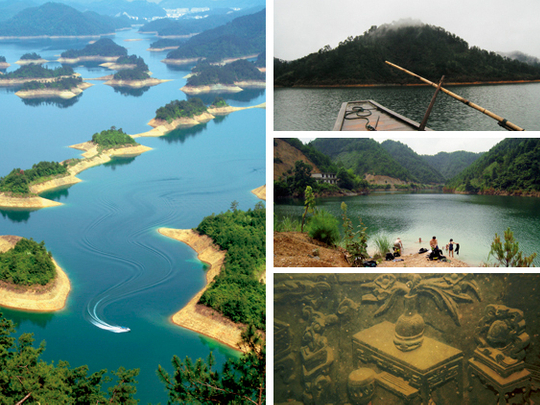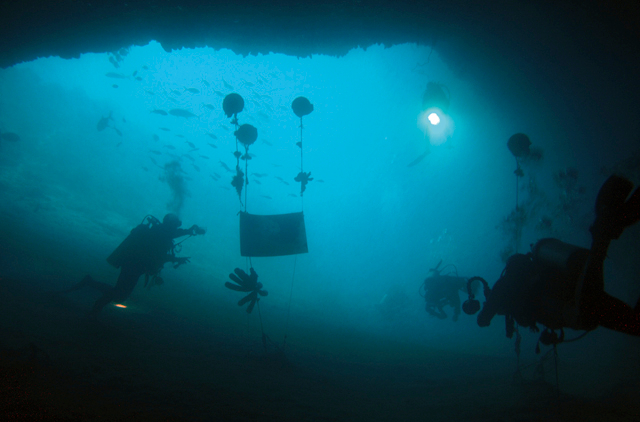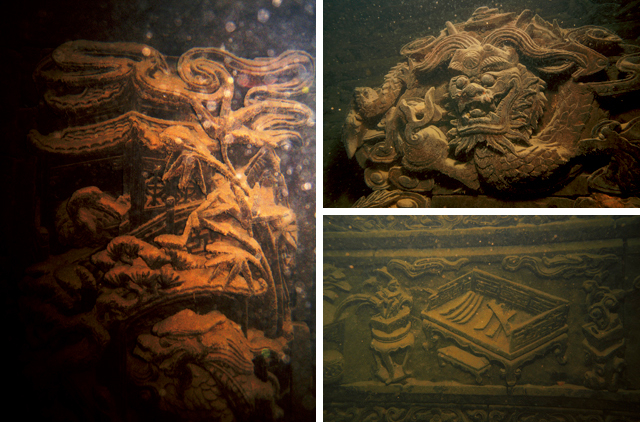
The lost city of Shi Cheng hides peacefully under the 573-square-kilometre Qiandao Lake. Its ruins are more than 1,300 years old and around two square kilometres in area. They disappeared off the map half a century ago after being evacuated and flooded during the construction of a reservoir. Although the government has always known the city’s secret location, it took the Big Blue dive company more than 100 dives beneath the lake’s surface to find the city.
“My friend had been doing research and had some rough GPS coordinates,” explains Big Blue owner Leigh Chen. “He told me the location of this ancient city in 2007, but the numbers were not exact. Finally, after two years, we found it.” The dive centre has been holding regular scuba expeditions here ever since, and on every dive they discover another piece of Shi Cheng’s fascinating puzzle.
Bizarrely, because the dormant city is sheltered from potential erosion from wind, sun and rain, it remains completely preserved. Experts predict that this perfectly natural capsule of history will stand the test of time. However, Big Blue has an Indiana Jones-like mentality about its findings. The company’s divers have guarded this secret location from other dive outfits so they can preserve Shi Cheng’s relics. “Other dive centres don’t just want to take people to dive there,” explains Big Blue dive instructor Paul Adams. “They want to collect artefacts under the water. That’s not what we are doing.”
Little by little, with dive customers in tow, Big Blue brings Shi Cheng (which mean’s “Lion’s City”) back to life during the underwater tours. The adventurous can swim through it, take photographs of their findings and even help collect information from former residents – many of whom still live in the surrounding area.
Paul explains that this will be an exciting but challenging dive. “If you go to this site, you must go with a guide,” he says. “You don’t want to get lost or trapped. Our guides always carry knives because fishermen cast over the underwater city and there are dangerous lines that have snagged trees and branches. You have to have your wits about you and not lose direction.”
The sun is bright on our visit and the puffy clouds reflect on the lake’s shimmering surface as far as the eye can see. It is hard to believe that there is a whole city beneath these tranquil waters. Before we descend into this deep, dark void, Paul puts things into perspective. He explains that although the water in the lake is extremely clean (it’s even bottled and sold under the brand Nongfu Spring), visibility can be as little as four metres.
“At points you can’t tell which way is up or down. It will be daunting and disorientating at first.” Parts of the lake are 120 metres deep, and divers can get into serious trouble if they get separated from the group while in the vast unknown abyss. However, parts of the city sit as shallow as 24 metres. “There’s about one metre of mud down there too,” says Paul. “If you drop too fast you’ll look like you’ve lost your legs,” he chuckles.
“The first thing most people do is kick their fins, which makes the mud go everywhere and spoils the visibility. Not advisable,” he urges. “Try to stay horizontal”. Our group of six look petrified; we all have fears of losing our diving buddies and being left in the darkness alone. Despite the palpable nerves, adrenaline levels are high and no one backs out.
The surface temperature of this large body of water is surprisingly mild, around 25 degrees Celsius, but as we begin our descent we are shocked at the severe change in temperature. Hitting the thermocline (the layer between warm and cold water) it plummets to 16 degrees and the water turns bottle green. There’s just enough light to see a couple of metres in all directions. Descending further, only fragments of light remain. Tensions are rising and the darker it becomes, the harder we breathe… It turns pitch black.
Our hearts almost stop for a second, until Paul flicks on a high-powered torch and lights our path. We pause at 22 metres down, count heads and prepare to swim toward the lost city. Through the murky, dark waters, we finally come face to face with a seven-metre wall – the edge of the underwater city. Five stone tunnels through the oval-shaped structure are the only paths inside the walls.
At the opening of the tunnel, Paul attaches us all to a line and leads the way. With complete trust in our guide, we carefully negotiate all our equipment in the tube, trying not to bash our tanks (lifelines) in the confined space. We know there’s no backing out now, no quick escape and no guessing what we may be confronted with.
On the other side of the tunnel, menacing darkness continues to loom around us. We feel a sudden jerk on the rope. A diver beckons us toward a murky shadow. Out of the blue appears an intricately detailed Pai Fang archway, with Chinese characters etched in the stone. The divers release a muffled ‘whoop’ and cheer through their regulators at their discovery.
It’s believed that one of the characters etched in to the structure (Sheng Zhi with a dragon) is the mark of an emperor, and the other next to it (Xiao Jie), symbolises women who respect and honour their families. The city was once a political hub in the Sui’an county, and much of the architecture contains adages or messages. There are an estimated 265 arches under the water, and each has different etchings or gruesome gargoyle-esque figures guarding the gateways.
On our second dive into the city, we encounter actual buildings – some stone, some wooden. Many have corridors, windows and rooftops fully intact. “We never enter the wooden buildings or any structure with thin walls because they are not stable enough,” Paul says. “Bubbles are enough to collapse an entire building, so we won’t take any risks.” In the crannies, we spot the city’s new inhabitants – freshwater fish and coral.
Back on land, we dry off and head into town. “Some wonderful marine life has moved into the city,” smiles Leigh. “It’s just waiting for new visitors.” It’s a bizarre feeling knowing that an hour ago we were swimming where the town’s older generation may have once slept. It’s even more surreal knowing that many of this town’s younger population are oblivious to the fact that there is a colossal underwater city close by, begging to be explored by those who dare.












